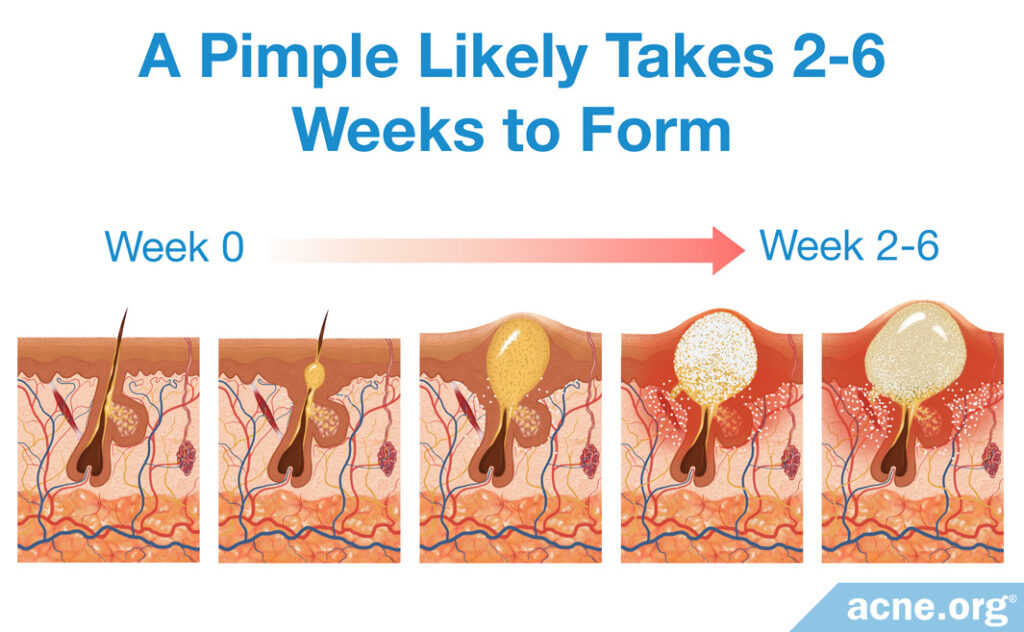Views: 7
2 – 6 Weeks Is the Dermatology Community’s Best Educated Guess

The Essential Info
Even though getting a pimple seems like a simple thing, when we look into the skin and exactly how it happens, many factors come into play. It is also very difficult for dermatology researchers to “catch” a pimple at its earliest stages when it is microscopic and then follow it all the way along.
Therefore, even though it may seem hard to believe, the only evidence we have on how long it takes a pimple to form relies on studies that focus on testing cosmetic ingredients for their ability to clog pores. These studies have suggested that pimple formation takes anywhere from 2 – 6 weeks.
What This Means in the Real World: The research evidence we have is limited, and in the real world, most of us have noticed that certain things predictably lead to a breakout a couple of days later. Perhaps the studies so far only show us part of the picture, and maybe some acne triggers, like stressing out about a test, might cause pimples to pop up in short order. Having said that, if you get a breakout “out of the blue,” keep the research in mind and consider that the breakout may be from something that initiated the pore-clogging process as far back as a couple/few weeks ago. For instance, if you get a sunburn, you might find yourself breaking out 2 or 3 weeks later.

The Science
- Cosmetic Product Testing Gives Us A Clue (2-4 weeks)
- Blackhead Removal and Reformation Gives Us Another Clue (2-6 weeks)
- Conclusion From What We Know
Scientists believe that for main factors contribute to acne development:
- Inflammation: Inflammatory molecules in the skin start off the whole chain of events
- Skin cell overgrowth: Skin cells overgrow, causing a clogged pore
- Skin oil (sebum): Skin oil gets trapped in a clogged pore
- Acne bacteria: Acne bacteria overgrows in the clogged skin oil1-4
However, researchers have been unable to conduct studies which can accurately observe the timing of each of these four factors because they lack the proper technology to detect the complex, intricate, and microscopic beginning stages of pimple formation.
Cosmetic Product Testing Gives Us A Clue (2-4 weeks)
The difficulty in investigating the exact timing of pimple formation has led scientists to turn to cosmetic product testing as a way to identify how long it takes for a pimple to form. Certain cosmetic ingredients, called comedogenic ingredients, are known to clog pores and lead to acne lesions. When these ingredients are tested on patients, pimples start becoming apparent after four weeks of treatment. This has led researchers to conclude that in humans, the pimple formation process may take around 4 weeks.6,7
However, some modern microscopes have been able to capture an initial clogged pore forming after only 2 weeks of applying a comedogenic ingredient to the patient’s skin.8 While an initial clogged pore may not be visible to the naked eye, it is the very beginning of a pimple.
Thus, we might say that it takes 2 to 4 weeks for a pimple to form.
Blackhead Removal and Reformation Gives Us Another Clue (2-6 weeks)
Blackheads are a type of acne lesion that give us another unique window into how long a pimple might take to form. When blackheads are forcibly removed from the skin, they tend to begin to start to reform immediately. Research has found that blackheads will completely reform in 2-6 weeks after removal, suggesting that it may be reasonable to assume that a 2-6 week range is how long it takes for an acne lesion to form.9,10
Conclusion From What We Know (A Range of 2-6 weeks)

Cosmetic ingredient testing shows us that clogged pores can form in as little as 2 weeks, and visible pimples can rear their heads at about 4 weeks. Also, we know that blackheads tend to reform 2-6 weeks after removal. So, a good educated guess on how long it takes for a pimple to form is 2-6 weeks.
References
- Toyoda, M. & Morohashi, M. Pathogenesis of acne. Medical Electron Microscopy 34, 29-40 (2001). https://www.ncbi.nlm.nih.gov/pubmed/11479771
- Purdy, S. & Berker, D. Acne vulgaris. Clinical Evidence 2011, 361-372 (2011). https://www.ncbi.nlm.nih.gov/pubmed/21880356
- Zouboulis, C. C. Acne and sebaceous gland function. Clinics in Dermatology 22, 360-366 (2004). https://www.ncbi.nlm.nih.gov/pubmed/15556719
- Tanghetti, E. A. The role of inflammation in the pathology of acne. Journal of Clinical and Aesthetic Dermatology 6, 27-35 (2013). https://www.ncbi.nlm.nih.gov/pmc/articles/PMC3780801/
- Das, S. & Reynolds, R. V. Recent advances in acne pathogenesis: Implications for therapy. American Journal of Clinical Dermatology 15, 479-488 (2014). https://www.ncbi.nlm.nih.gov/pubmed/25388823
- Draelos, Z. D. & DiNardo, J. C. A re-evaluation of the comedogenicity concept. Journal of the American Academy of Dermatology 54, 507-512 (2006). https://www.ncbi.nlm.nih.gov/pubmed/16488305
- Waranuch, N., Wisutthathum, S., Tuanthai, S., Kittikun, P., Grandmottet, F., Tay, F. & Viyoch, J. Safety assessment on comedogenicity of dermatological products containing d-alpha tocopheryl acetate in Asian subjects: A double-blind randomized controlled trial. Contemp Clin Trials Commun. 23, 100834 (2021). https://pubmed.ncbi.nlm.nih.gov/34471722/
- Baek, J. H., Ahn, H. J., Koh, J. S., Kwon, H., Shin, M. K. Early detection of microcomedones induced by cocoa butter using reflectance confocal microscopy. J Cosmet Dermatol. 21, 3016-3021 (2022). https://pubmed.ncbi.nlm.nih.gov/34632684/
- Lora, V., Capitanio, B. & Ardig, M. Noninvasive, in vivo assessment of comedone re-formation. Skin Research and Technology 21, 384-386 (2015). https://www.ncbi.nlm.nih.gov/pubmed/25601513
- Cunliffe, W. J., Holland, D. B. & Jeremy, A. Comedone formation: etiology, clinical presentation, and treatment. Clin Dermatol. 22, 367-374 (2004). https://pubmed.ncbi.nlm.nih.gov/15556720/
The post How Long Does It Take for a Pimple to Form? appeared first on Acne.org.

